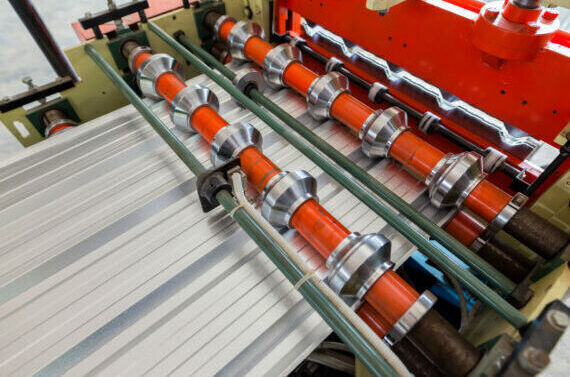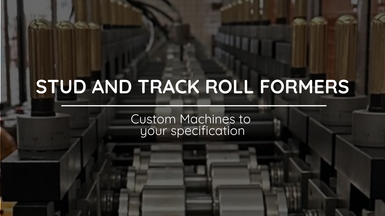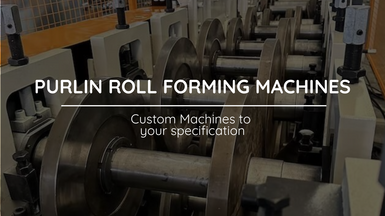
Pre cut Forming Lines
Typically, two options exist for producing length-specific formed parts with a roll-forming machine.
Posted on Wednesday, March 29, 2023
Pre-cut lines work by cutting the metal prior to it entering the roll-forming line, while post-cutting works through a shear that cuts the steel coil after it has been formed.
Pre-cut or post-cut - which is better?
There are advantages to both methods, and determining which is suitable for your end product will depend on several factors.
The advantages of pre-cut forming lines
Because the shear is cutting in the flat, it can be fed into the roll former producing multiple profiles without changing the shear blades. A profile-specific blade or a slug cut is not necessary. Another advantage of pre-cut roll forming is that running numerous profiles on the same line becomes much easier.
Higher production lines also tend to benefit from pre-cut roll-forming lines. Stop time can be minimized by accumulating steel into a pit. Using a rotary sheer can also increase production rates.
On a pre-cut shear, all four sides of the flat blades can be used without sharpening them. Profiled blades on a post-cut aren’t reversible, which means surface grinding would be required more frequently. If flat sheets to feed a secondary operation are required, it is possible to add a conveyor to the pre-cut line after the shear. This allows the operator to remove the blanks prior to entering the machine. Pre-cut shears that have been designed to shed a flat pattern permit useful production features such as notching, punching, or integrating tabs to the end profile.
The advantages of post-cut forming lines
Because the roll former is full of sheet metal, this eradicates the need for a min length requirement which is very beneficial when running short sheets to produce ridge caps or in the production of soffit or wainscot. If the line cannot produce short sheets, manual cutting of longer sheets will be required, which means extra costs in production and labor as an additional shear will be necessary to cut any longer sheets to size manually.
Post-cutting also means a reduction in end-flare. While end-flare in pre-cut roll-formed parts is almost inevitable, the amount of end-flare can be minimized thanks to the ability to control the part more easily with the help of additional roll tooling and side or flare roll fixtures. Due to the one long part being formed continuously and subsequently cut into smaller lengths, end flare is minimal in post-cut machines.
Because there is typically no requirement for an entry conveyor thanks to the infeed table being mounted directly on entry of the roll former., a post-cut machine should generally require a shorter footprint. Alignment issues are also minimal because of the continuous feeding into the machine.
Tooling wear is also less likely when using a post-cut machine. This is because they don’t require powered upper tooling passes to drive the sheet meaning the tooling can turn freely. Friction against the part is also reduced because of this.
Thanks to ever-evolving technology, pre and post-cut roll-forming lines are widely used and considered effective in the mass formation of metal parts. Thanks to servos and closed-loop controls, more accuracy and speed can be applied to post-cut flying shears. Servo-controlled anti-flare fixtures have also levelled the playing field for post-cut machines meaning the flare tolerance is comparable to that of a post-cut device.
Finally, while some manufacturers may be concerned about the scrap that is typically associated with post-cut lines, some modern lines now include an advanced control feature that tracks the last part.
Deciding whether you require pre or post-cut forming lines can be challenging. Call the team at Roll forming LLC today, and we can help you make an informed decision.
Roll Forming Machines LLC's New Factory
Posted on Sunday, March 23, 2025
We have relocated factories, which will be available for tours very soon.

Uncoiler, Decoiler and Coil Car Roll Forming Machine Accesories from Roll Forming Machines LLC
Posted on Sunday, November 24, 2024
Contact us today with your specifications for a custom Uncoiler, Decoiler or Coil Car at [email protected] or call us at (+1) (407) 859 1119

Stud and Track Roll Forming Machines from Roll Forming Machines LLC
Posted on Saturday, November 23, 2024
Contact us today with your specifications for a custom Stud and Track Machine at [email protected] or call us at (+1) (407) 859 1119

Cee and Zee Purlin Roll Forming Machines from Roll Forming Machines LLC
Posted on Saturday, November 23, 2024
Contact us today with your specifications for a custom Cee and Zee Purlin Machine at [email protected] or call us at (+1) (407) 859 1119